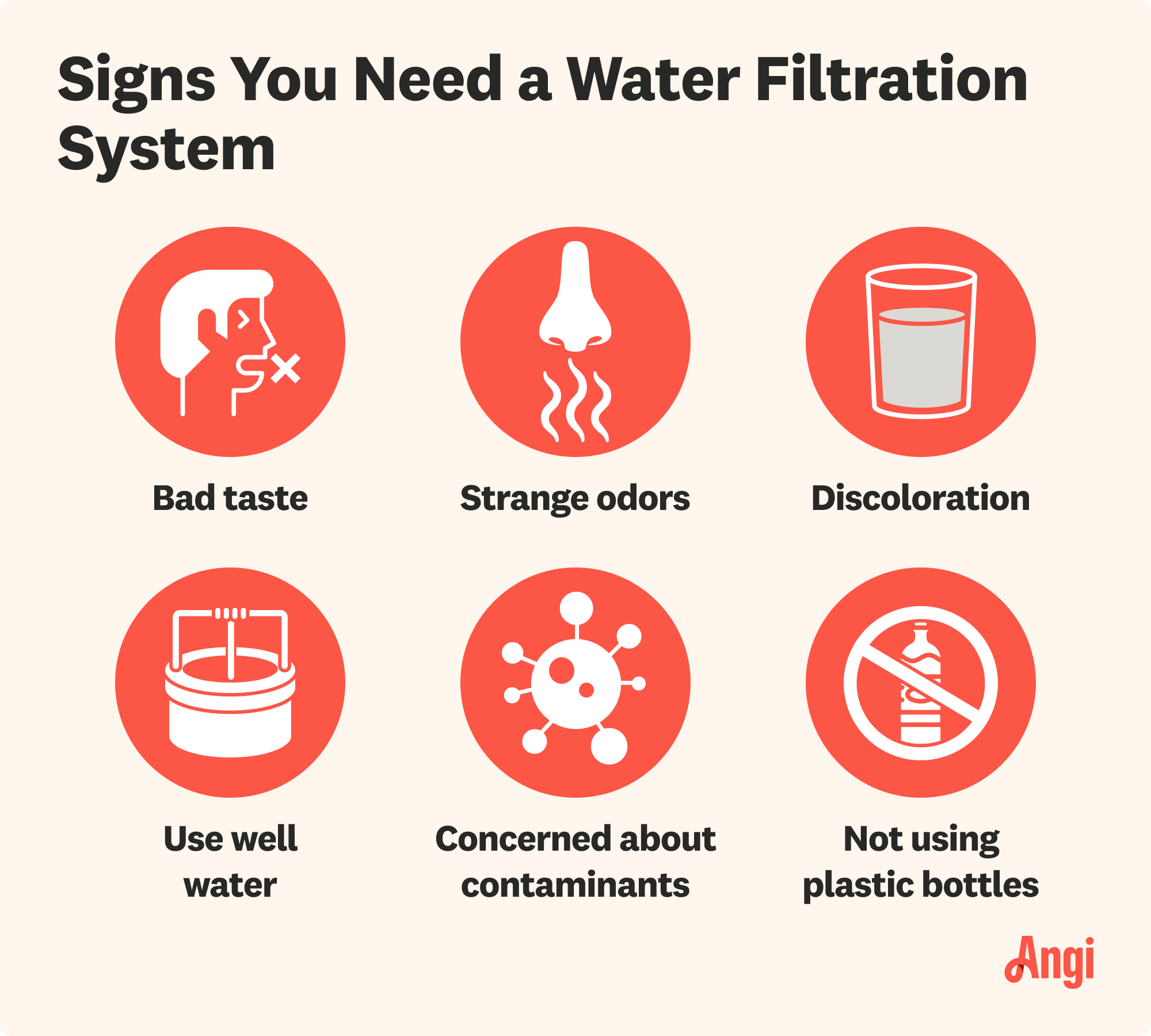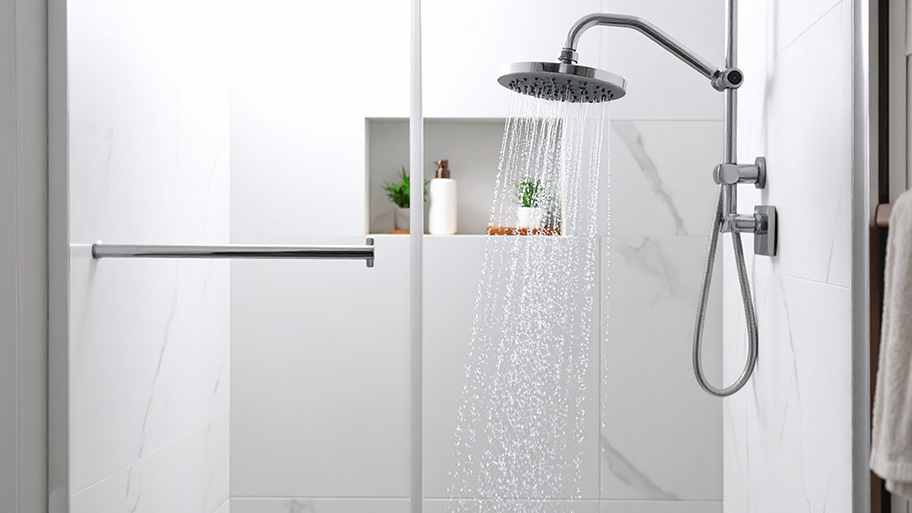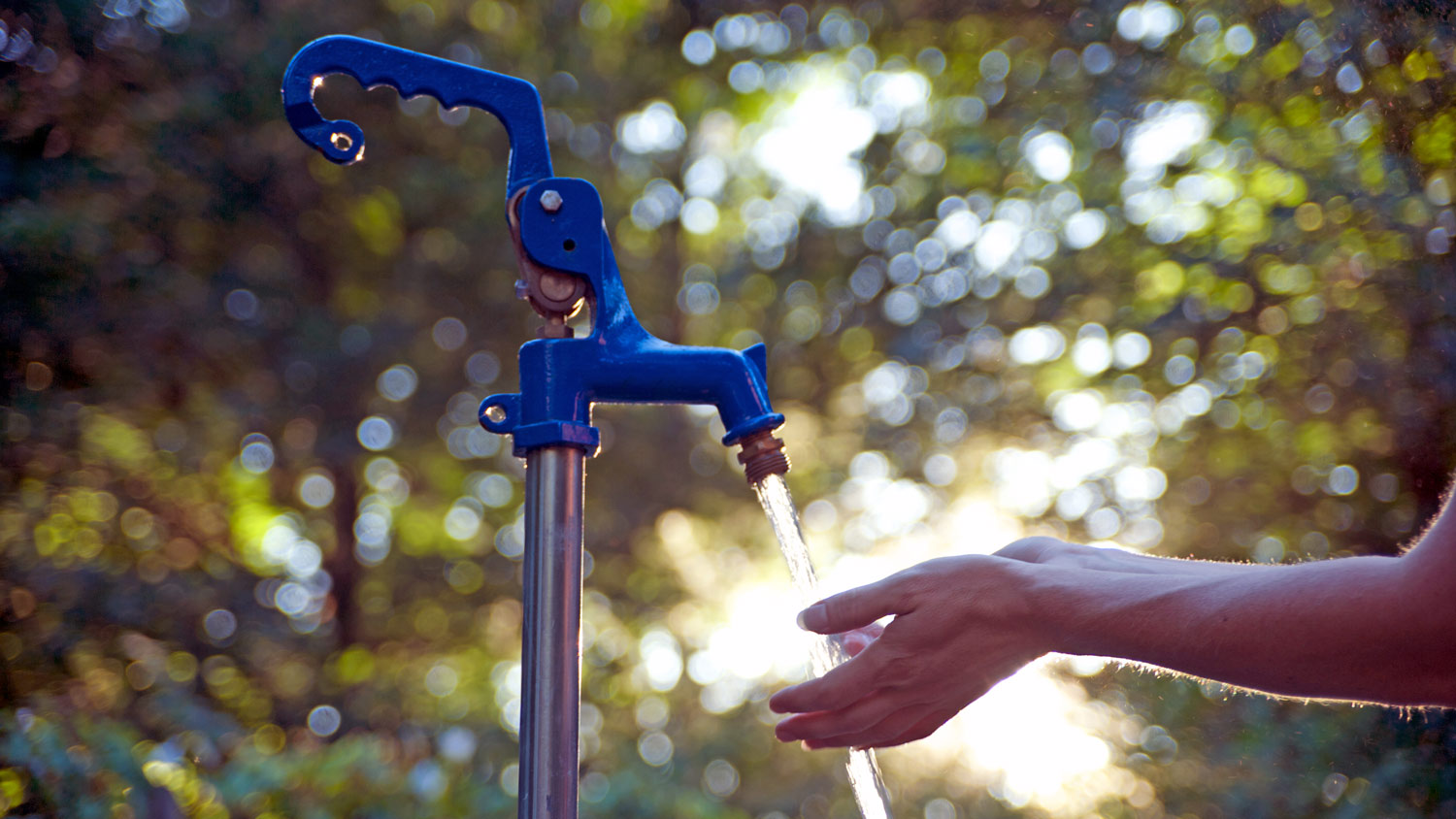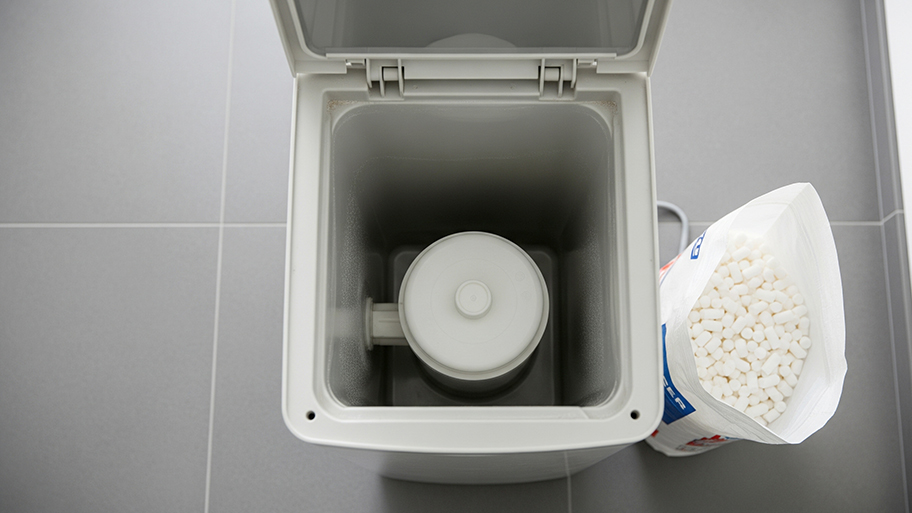
On average, a reverse osmosis water filter costs around $2,200, but there are a few variables that impact the total price. Learn about them in this guide.
Let it flow, let it flow, let it flow


A local water softener pro can help you choose from the more than 10 different water filters on the market based on your budget and your household's needs.
Activated carbon and reverse osmosis filters are among the most popular—and priciest—options.
Distillation is both expensive and ineffective because it removes beneficial minerals in addition to harmful ones.
Investing in a water filter pitcher is an inexpensive, low-lift shortcut to cleaner water.
There are 10 main types of water filters: mechanical, activated carbon, reverse osmosis, ion exchange, ultraviolet, ceramic, distillation, infrared, activated alumina, and microfiltration. If you’re looking to bring cleaner, fresher-tasting water into your home, a water filtration system is a good investment. However, with so many different types of water filters available, understanding your options can get a bit overwhelming. Read on to explore the basics of today’s most common water filters, including how each type works and its pros and cons.

A mechanical water filtration system uses a mesh barrier, screen, or porous material to prevent contaminants—like sediment, dirt, and rust—from entering your water supply. They have a micron rating that reflects how effective the filter is. Lower ratings equate to better particle-blocking capabilities.
| Pros | Cons |
|---|---|
| Moderately priced | Doesn’t get rid of chemicals |
| Easy to install and maintain | Filters need regular changing |
| Improves water clarity | Can’t remove microorganisms |
Best for: Filtering out visible debris and sediment
These water filters have a bed of activated carbon that traps chlorine and volatile organic compounds (VOCs). They can also remove some pesticides and heavy metals (including lead), but they don’t work on minerals, microbes, or salt. Like mechanical filters, activated carbon filters often serve as one of the first stages in multi-stage water filtration systems.
| Pros | Cons |
|---|---|
| Gets rid of pesticides, VOCs, and certain heavy metals | Can’t remove minerals, microbes, or salt |
| May improve water’s smell and taste | Not effective against inorganic pollutants |
| Fairly cost-effective and simple | Requires periodic filter changes |
Best for: Eliminating VOCs, chlorine, certain heavy metals, and pesticides
Reverse osmosis (RO) filters force water through a semipermeable membrane under high pressure. This process removes contaminants and impurities as small as an ion, including chemicals, microorganisms, dissolved salts, and heavy metals.
| Pros | Cons |
|---|---|
| Capable of removing most contaminants | Pricier than many other options |
| Can decrease water hardness | Wastes water |
| May improve water’s taste | Strips healthy minerals from water |
Best for: Producing ultra-clean drinking water that’s free from nearly all contaminants
Ion exchange filters swap hard water ions (such as calcium and magnesium) for softer ones (like sodium and hydrogen). They effectively serve as a water softener, which makes them suitable for areas with hard water. However, they can’t remove many types of contaminants, including bacteria, viruses, and VOCs.
| Pros | Cons |
|---|---|
| Reduces water hardness | Increases sodium levels in water |
| Limits limescale buildup in pipes and appliances | Doesn’t remove bacteria or organic contaminants |
| Blocks heavy metals | Expensive to run |
Best for: Minimizing scale buildup and softening hard water
The main difference between soft water and hard water is the mineral content. Hard water has higher levels of calcium and magnesium, whereas soft water has undergone a process to remove these minerals.

When water passes through an ultraviolet (UV) filter, it’s sanitized by a UV light. This light damages the DNA of any microorganisms in the water, including bacteria and viruses, which disrupts their ability to reproduce and harm your health. UV filters are excellent for disinfection, but they’re most effective when paired with filters that can block other contaminants.
| Pros | Cons |
|---|---|
| Removes microorganisms | Doesn’t filter out chemicals or heavy metals |
| Energy efficient | Works best with clear water |
| Works without chemicals | Can’t remove particles |
Best for: Eliminating bacteria and viruses
Ceramic is a porous material, so when it’s used as a water filter, it can trap bacteria, parasites, and other contaminants. These cost-effective filters can be found in areas where waterborne diseases—like E. coli and salmonella—are a concern. However, their filtration capability is somewhat limited, so it’s best to use them in conjunction with other filters.
| Pros | Cons |
|---|---|
| Inexpensive | Not good for removing viruses, heavy metals, or chemicals |
| Works well against bacteria and parasites | Needs regular cleaning and maintenance |
| Suitable for remote or resource-limited communities | Slow filtration |
Best for: Filtering out bacteria and sediment in places with limited clean water
Distillation is a water purification system that involves capturing the steam from boiling water, then letting it cool and condense back into a liquid. As the vapor cools, it leaves behind many impurities and contaminants, including minerals, heavy metals, bacteria, and viruses. The result is a highly purified form of water, which is often used in laboratory and medical settings.
| Pros | Cons |
|---|---|
| Eliminates many contaminants | Expensive to run |
| Creates exceptionally pure water, no matter the quality of the source water | Time-consuming filtration process |
| Doesn’t use chemicals | Removes beneficial minerals |
Best for: Situations where ultra-pure water is necessary, like medical work
This type of water filter system uses infrared light to change the physical qualities of water, decreasing the size of the water molecules so that they’re more easily absorbed by the body. This process softens the water but doesn’t remove contaminants, so infrared filters should be integrated with other types for maximum filtration.
| Pros | Cons |
|---|---|
| Softens water | Doesn’t get rid of physical contaminants |
| Fairly easy to install and maintain | Pricey |
| Works with other types of filters | Newer filtration method with debatable effectiveness |
Best for: Pairing with other types of filters
As water moves through an activated alumina filter, certain contaminants—including arsenic, fluoride, and selenium—attach themselves to the alumina (aluminum oxide). It works much like an activated carbon filter, except it removes different contaminants. Before installing one of these filters, make sure you know how to dispose of them responsibly without harming the environment. If you have questions, contact a local water softener installation company.
| Pros | Cons |
|---|---|
| Blocks arsenic, fluoride, and selenium | Doesn’t filter out bacteria or many other contaminants |
| Relatively affordable | Water’s pH level impacts its effectiveness |
| Doesn’t remove beneficial minerals | Filter disposal can be tricky |
Best for: Regions where fluoride, arsenic, and selenium levels are particularly high
In a microfiltration system, water flows through a porous membrane, which captures large particles and certain microorganisms, including bacteria and some viruses. While they are energy-efficient and chemical-free, microfilters aren’t effective at removing chemicals or dissolved contaminants.
| Pros | Cons |
|---|---|
| Blocks solids and some microorganisms | Can’t filter dissolved contaminants, including salts and minerals |
| Doesn’t use chemicals | Pores are small and can get clogged |
| More energy efficient than many other filters | Installation can be expensive |
Best for: Filtering out bigger particles, bacteria, and certain viruses
According to Angi customers, 36% of homeowners—or nearly 4 out of 10—notice a strange taste or odor in their home's water. Some people detect the smell of rotten eggs or chemicals. For others, the water may taste metallic or salty. Call a pro to get to the bottom of the issue.
The best filter for your home’s drinking water depends on your household's needs and budget. If you have a large household with several people drinking tap water, you’d be wise to invest in a whole-whole-home water filtration system since it provides filtration to all your faucets 24/7. However, under-sink filtration systems are ideal for smaller homes with just one to three household members. If you live solo, you’d be fine with a water pitcher filter to meet your filtration needs.
Randy and Zach are super professional. They promptly provided the water softener/RO with all the specifications and went into great detail to explain the system and its usage. I highly recommend these people. You cannot get this deal anywhere else.
Good to work with trust haven solution they provided good service for my computer I will also recommend their services to others also. They are very timely with their monthly checks and reminders to have service completed.
This is a small family owned company that will give you excellent service.
A very good company to work with: professional, reasonably priced, and willing to go above and beyond to satisfy the customer. We had rotted wood and new aluminum roof trim installed, and the result is perfect and done on time. I definitely recommend them and will certainly use them for...
The service was excellent! Norwin's trap caught the dangerous bob cat in short order. I am very thankful!
Wayne and his son replaced a 4x8 piece of tempered glass in our sun room , the whole job from start to finish was truly fantastic and very professional !! Highly recommended !! Thank you !!
Brandon Burnette did such a great job. I'm so happy I had him as my worker today. Very nice and friendly young man. 10 star in my book.
We had LHR install a new roof and gutter system. While they were not the cheapest, they were considered the most reliable and fetish for using only high-value products that would last for many years. Additionally, they were highly professional and never tried to push their services or any...
Valley Crest is hands down the best contractor we have ever worked with. He had done more than one project for us, in fact, he does all the builds we have. From our deck to our porch, the projects he has done are the best we have ever seen. ((Wish the site would let us put more than one...
I needed a new hot water heater and Mitch did a great job.
From average costs to expert advice, get all the answers you need to get your job done.

On average, a reverse osmosis water filter costs around $2,200, but there are a few variables that impact the total price. Learn about them in this guide.

Water softener repair costs can add up, but they’re almost always worthwhile. Use this guide to see what your project is going to cost before you get started.

Discover how much well water treatment systems cost, including installation, maintenance, and tips to save. Get expert insights to plan your water system project.

What is hard water? It contains high levels of minerals that dry skin and hair, stain dishes and clothes, and limit the life span of plumbing and appliances.

If your water softener is constantly draining, you may have a stuck valve, old seals, or electrical issues. Explore more common problems and solutions here.

There are many pros and cons of salt-free water softeners that could impact your decision to buy one. Stay tuned to learn more about salt-free water softeners.